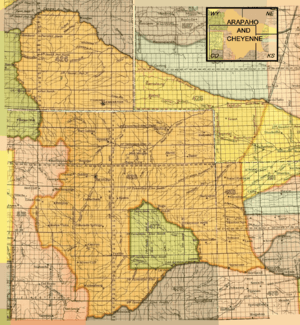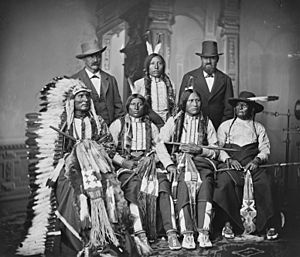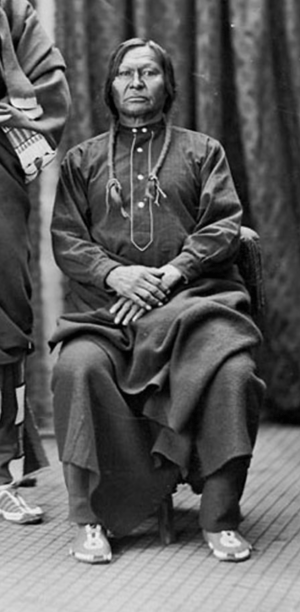Friday (Arapaho chief) facts for kids
Friday (whose Arapaho names were Teenokuhu or Warshinun) lived from about 1822 to 1881. He was an important Arapaho leader and interpreter in the mid to late 1800s. When he was about eight years old, he got separated from his family. A white fur trapper named Thomas Fitzpatrick found him and took him in. For the next seven years, Friday went to school in St. Louis, Missouri. He also joined Fitzpatrick on trapping trips. Later, his mother recognized him during a meeting with the Arapaho people, and he returned to his tribe.
His tribe called him the "Arapaho American." Friday was a translator, interpreter, and peacemaker. He helped create peace agreements and understand different cultures. He traveled with and translated for explorers like John C. Frémont in 1843 and Rufus Sage in 1844. He also helped Ferdinand V. Hayden during his land surveys. In the winter of 1859–1860, Friday even taught Hayden some Arapaho words. Friday became the leader of a group of Arapaho people who lived near the Cache la Poudre River (close to Fort Collins, Colorado today). They also traveled into Wyoming, Kansas, and Nebraska. He made friends with white settlers in northern Colorado. He helped his tribal members find jobs on farms and ranches after they lost access to their traditional hunting grounds. After many tries to get a reservation for the Northern Arapaho in Colorado or Wyoming, Friday and his people finally moved to the Wind River Indian Reservation.
Contents
Friday's Early Life
Friday was born around 1822 as part of the Northern Arapaho people. His Arapaho name, Teenokuhu, meant "sits meekly." He was also called Warshinun, which meant "black spot." In 1831, his group was camped with the Atsina (Gros Ventre) people along the Cimarron River in what is now southeastern Colorado.
A fight started when 30 Mexican traders arrived. During the confusion, Friday and two other boys got separated from their group. They wandered for several days in the Great Plains or mountains. A white trapper named Thomas Fitzpatrick found Teenokuhu on a Friday. That's how he got the name "Friday." Fitzpatrick took him in, and Friday went to school for two years in St. Louis, Missouri.
Friday went with Fitzpatrick on his fur trapping trips. He met other trappers who were amazed by his "astonishing memory." They also noted his careful observations and interesting questions. At one point, Fitzpatrick worked for the Bureau of Indian Affairs, helping with Native American relations.
Arapaho Leader and Interpreter
Returning to His People
In 1838, Fitzpatrick and Friday met a group of Arapaho people. A woman recognized Friday as her son, and he returned to live with his tribe. Friday's life was mostly centered around the Cache la Poudre River area, near what is now Fort Collins. He was a skilled hunter and warrior. Friday fought against the Ute, Shoshone, and Pawnee people.
His tribe called him the "Arapaho American." Friday was a translator and interpreter, and he was known as a peacemaker. He was the only Arapaho person who spoke English from that time until he died in 1881. He traveled with and translated for explorers like John C. Frémont in 1843 and Rufus Sage in the spring of 1844. Sage traveled along the Arkansas River in southern Colorado.
The Fort Laramie Treaty of 1851

Friday attended a special meeting for a treaty at Fort Laramie, Wyoming in 1851. The Fort Laramie Treaty was finished and signed in October of that year. Friday was one of twenty-one Native American chiefs who signed the treaty. The treaty said that Native Americans could continue to use their traditional lands. In return, they agreed to stop attacking non-native travelers and allow the military to build forts and roads. During these talks, Friday went to Washington, D.C., with other Arapaho and Cheyenne leaders to discuss some concerns.
Working as an Interpreter
In 1857, Friday worked as an interpreter when the Arapaho met Mormons in Wyoming. In 1859, he did the same when Little Owl's group visited a survey team led by Ferdinand V. Hayden. Hayden learned Arapaho words from Friday in the winter of 1859–1860. This happened on Deer Creek, near what is now Laramie, Wyoming.
Moving Out of Colorado
By the 1860s, many white people moved into Colorado. This forced the Arapaho people out of their lands. A terrible event happened in 1864, known as the Sand Creek massacre. More than 200 Arapaho and Cheyenne people were killed by the 1st Colorado Cavalry Regiment.
Friday's group became smaller because of attacks by the United States Army, diseases, and hunger. White settlers took over their traditional hunting grounds. In the late 1860s, Friday's group had about 175 people. They lived in northern Colorado along the Cache la Poudre River. Governor Alexander Hunt pushed Friday's group out of Colorado Territory and north of the Platte River in 1869. They went to the Tongue River. Friday's camp was about 50 miles (80 km) from Fort Phil Kearny in Wyoming. Black Bear's and Medicine Man's groups, who had also been forced out of northern Colorado, joined them.
The Fort Laramie Treaty of 1868
In early 1868, government peace leaders hired Friday. These leaders included Army generals led by General William T. Sherman. Friday's job was to tell the Northern Arapaho that they needed to sign a treaty to keep getting supplies. The Northern Arapaho and Northern Cheyenne met at Fort Laramie. They signed the Treaty of Fort Laramie on May 10, 1868.
Black Bear, Little Wolf, Littlesheild, Medicine Man, and Sorrel Horse signed for the Northern Arapaho. They agreed to settle on one of three reservations within a year. Their choices were with the Lakota people on the Missouri River, with the Southern Arapaho and Cheyenne people in Indian Territory (now Oklahoma), or with the Crow people on the Yellowstone River in Montana Territory.
The Northern Arapaho wanted to stay in Wyoming. A meeting was held in October 1869. Sorrel Horse, Medicine Man, and Friday met with U.S. Army General Christopher Augur and Governor John Allen Campbell of the Wyoming Territory. Even though the Shoshone had been their enemies, the Wind River Indian Reservation in Wyoming was their preferred new home. Shoshone Chief Washakie did not come to the meeting. But in February 1870, he agreed to let the Arapaho stay at the reservation for a while.
Continuing to Negotiate
Friday kept working to protect the Northern Arapaho's traditional lands in Wyoming into the 1870s. His own son even became a scout for the United States Army. Friday's group joined with other Northern Arapaho groups. They left the Wind River reservation by the winter of 1870–1871. They hunted for the few animals left in the Powder River Basin. Needing food, they got supplies at the Red Cloud Agency near Fort Laramie in March 1871. Friday's group then went to live among the Lakota at Red Cloud's reservation in Montana.

Friday and other Northern Arapaho leaders met with President Rutherford B. Hayes and Interior Secretary Carl Schurz in September 1877. This was Friday's last trip to Washington, D.C. The leaders asked for a reservation for the Northern Arapaho in Wyoming. One month later, the Northern Arapaho returned to the Wind River Indian Reservation. They lived there alongside the Shoshone people. Friday lived at Wind River until he died in 1881, possibly near Fort Washakie.



